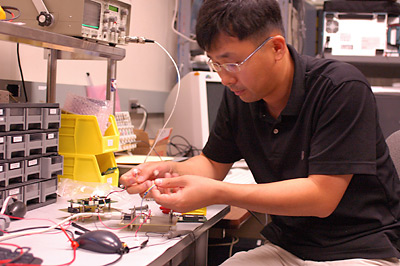Despite crash of rocket carrying Cornell satellites, program is called a success
By Lauren Gold

A Russian rocket carrying two Cornell-built satellites and satellites from nine other universities and one private company crashed shortly after launch near the Kazakhstan-Uzbekistan border Wednesday, July 26. The project, called CubeSat and developed by California Polytechnic State University and Stanford University's Space Systems Development Laboratory, was part of an ongoing effort to make space more accessible to students nationwide.
The rocket launch proceeded according to plan until after the first stage separation. The rocket then lost contact with the ground for many minutes before observers received official word that it had failed. The cause of the crash is under investigation.
The two Cornell ICE Cube satellites (ICE stands for Ionospheric sCintillation Experiment) were 4 inches and 2 pounds each. Built to study the effects of scintillations in the Earth's ionosphere on communication signals, the satellites involved more than 100 Cornell and Ithaca-area high school students over three years.
"A lot of work went into each and every CubeSat," said Laurence "Mike" Hammer, director of data management for engineering's Student Services and the project's communications adviser. "The primary mission was education, and we definitely did that. So in that respect, it's been hugely successful."
Mark Campbell, the project leader and an associate professor of mechanical and aerospace engineering, said he hopes the rocket failure doesn't cast a shadow over the CubeSat program.
"The whole objective was to give students more access to space," he said, adding that it would be unfortunate if disappointment from this mission causes people to lose enthusiasm for the idea.
"One of the benefits we have is that the satellite and the research we get out of it are not our product; the product is our students," he said, noting that many of the project's alumni have gone on to careers in aerospace engineering at the National Aeronautics and Space Administration, Jet Propulsion Laboratory and elsewhere. "I've gotten so many e-mails from students who worked on the project saying, 'Just to let you know, I wouldn't be where I am today without it.' It made me feel good about what we had accomplished from that end of it."
Media Contact
Get Cornell news delivered right to your inbox.
Subscribe